
By: Jonathan Simon on May 12th, 2021
5 Ways to Design in More Hot Water Efficiency
SYSTEM DESIGN | residential plumbing | CPVC
It's common knowledge homes have become much more energy-efficient over the past several decades. What’s not so widely understood is most of the energy savings are limited to increased efficiency in regulating the temperature of the homes’ living spaces, thanks to vastly improved heating, cooling, and insulation systems. For instance, while roughly 60% of a home’s energy use went to heating and cooling forty years ago, today the average is around 48%. In contrast, over that same time period, the percentage of a home’s energy required to heat and handle water has remained relatively unchanged at around 18%, partly because homes are bigger and often feature more bathrooms, creating additional opportunities for energy loss in distribution.
Don’t let that discourage you--you can be the exception to the rule. The key is to make decisions that will optimize the performance of your plumbing systems, ranging from the equipment and components you install to the configuration of the system itself.
1. Start with an efficient hot water heater.
There are three primary types of energy loss in a water heating system, two of which are directly related to the hot water heater itself: combustion loss and storage loss. (The third is through heat loss in distributing the water throughout the house, which we’ll discuss shortly.) In a conventional gas water heater, there’s about a 17% fuel energy loss during fuel combustion, and 31% heat loss while water sits in the tank. That means less than half the fuel energy actually reaches the point of use.
For comparison’s sake, here are common options to evaluate when it comes to supplying a home with hot water.
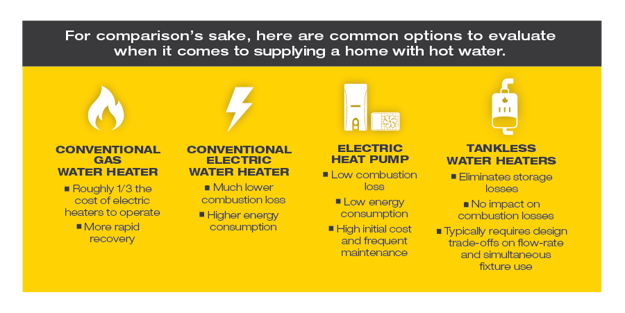
The best type of water heater for a home in Arizona may not be the most efficient choice for an Ohio home. Here are some factors to consider:
Fuel type, cost, and availability. Impacts the water heater's annual costs to operate as well as its size and energy efficiency.
Size. Balance between efficiency and supplying enough hot water for regular household use.
Energy efficiency. Compare the ratings of your various choices to maximize your energy and cost savings.
Costs. Estimate the annual operating costs of heaters and compare them with other less or more energy-efficient models to get an idea of your total costs.
2. Floorplan your way to greater efficiency.
Having areas of hot water usage in a home separated by extensive runs of piping can significantly impact the efficiency of the distribution. When it comes to piping, the more feet you use the more heat you lose. So while it is tempting to place that garden tub in the far corner of the house overlooking the waterfall, know that its distance from the water heater located in the opposite corner of the house will cost you in efficiency. Designing hot-water usage areas to be close to one another can significantly improve your energy efficiency.
3. Choose the right system configuration.
While there are multiple system designs to consider when designing a home’s hot-water distribution, there’s one basic fundamental to keep in mind. The key to an efficient design is to minimize the amount of hot water that’s stored in the pipe in between uses.
Trunk & Branch System
Any hot water use primes the trunk line with hot water, reducing subsequent wait times, making it highly efficient if hot water events are clustered together (mornings and evenings).
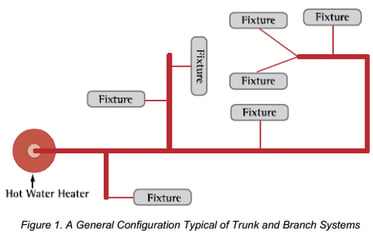
Core or Zone Plumbing System
Featuring multiple Trunk & Branch Systems built around a centrally located water heater, this configuration is highly efficient if designed so each zone experiences independent clustered use.
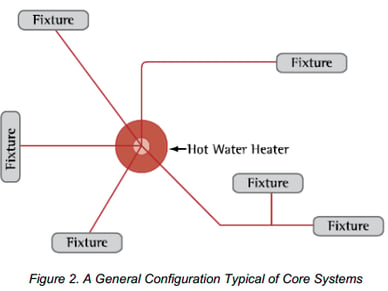
Central Manifold System
In this design, each fixture has an individual dedicated line that must be purged of cold water prior to use. Only efficient for individual hot water events, not clustered use, and requires 60% more pipe than a trunk and branch or core plumbing system.
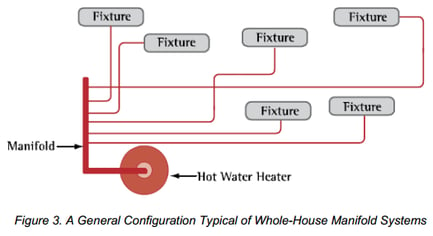
Remote Manifold System
A hybrid between a Trunk & Branch and Manifold system, this design features a main trunk line with small manifolds to serve zones, It can be highly efficient if dedicated lines are kept very short, but does use 20% more pipe than a Trunk & Branch or Core/Zone Plumbing System.
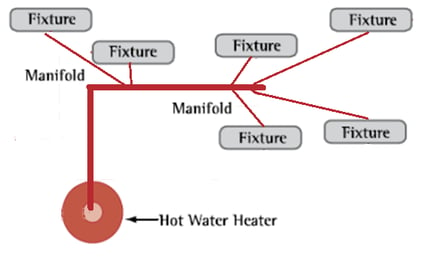
Recirculating System
Featuring a single loop for hot water serving all fixtures which loop back to the water heater, Recirculating Systems reduce water-heating energy required, though this savings is negated due to pump energy and heat loss in circulation if loop is continuously recirculating.
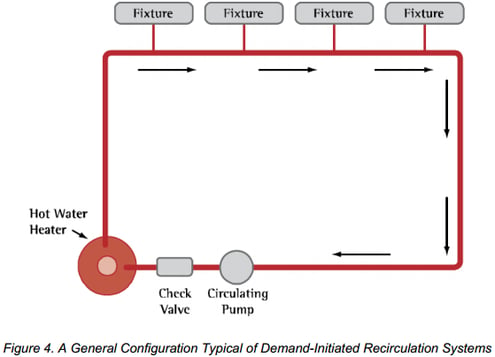
Above configuration diagrams courtesy of EPA WaterSense Guide for Efficient Hot Water Delivery Systems
For many homes, a Trunk & Branch system is often the most efficient. While properly designed and installed remote manifold systems can be more efficient, they are typically installed with branches that are too long, operating like inefficient central manifold systems. To select which design will be most energy-efficient for your particular home, it’s important to understand the demands that will be placed on the system. Where will hot water be needed? How often? And how much? In addition, the design of the home and the way the pipe is actually installed can significantly impact the overall efficiency of the system.
4. Proper insulation is essential to high efficiency.
To both maintain the heat of the water flowing through a pipe and slow the heat loss of water sitting in a pipe, insulation adds another layer of efficiency. In lab testing, insulation has been shown to reduce the rate of heat loss in pipes by 30-48%, with an average savings of 36%. That equates to an increase in the cooldown time of your water from about 15 minutes to 40 minutes, making it especially important if how water usages do not occur one after another. Given the low cost of insulation, whether or not to wrap your hot water lines is an easy decision to make.
5. Optimize efficiency in selecting your piping material.
Since energy losses in hot water distribution systems can be as high as 26% (with typical homes experiencing 10-15% losses), maximizing your efficiency by even a few percentage points at every opportunity can have a significant cumulative effect. This begins with your choice of the piping material itself.
Peer-reviewed research has generally concluded that CPVC plumbing systems, like FlowGuard Gold CPVC, tend to have lower energy and water losses than PEX systems and produce even greater savings when compared to copper. PEX and copper piping are both commonly used in radiant floor heating systems due to their significantly higher thermal conductivity when compared to FlowGuard Gold CPVC. The thermal conductivity of PEX is 284% higher and copper is more than 2000% higher than FlowGuard Gold CPVC. Because FlowGuard Gold CPVC piping experiences less heat loss through the pipe walls than other materials, it provides more efficient hot water delivery. While there are other factors that make CPVC an environmentally sound choice, it’s easily the material of choice when it comes to optimizing energy efficiency in hot water distribution.
Let us help you deliver hot water efficiently.
The FlowGuard Gold team has invaluable experience with virtually all the design configurations you may be considering and can offer advice and resources to help you make your decision. As the pioneers in CPVC piping, delivering water efficiently (both hot and cold) is a driving force behind everything we do.
Click here for our White Paper on earning LEEDS Credits with your plumbing system design.


